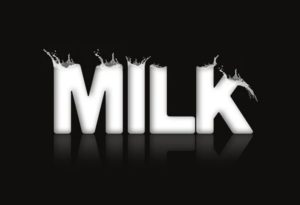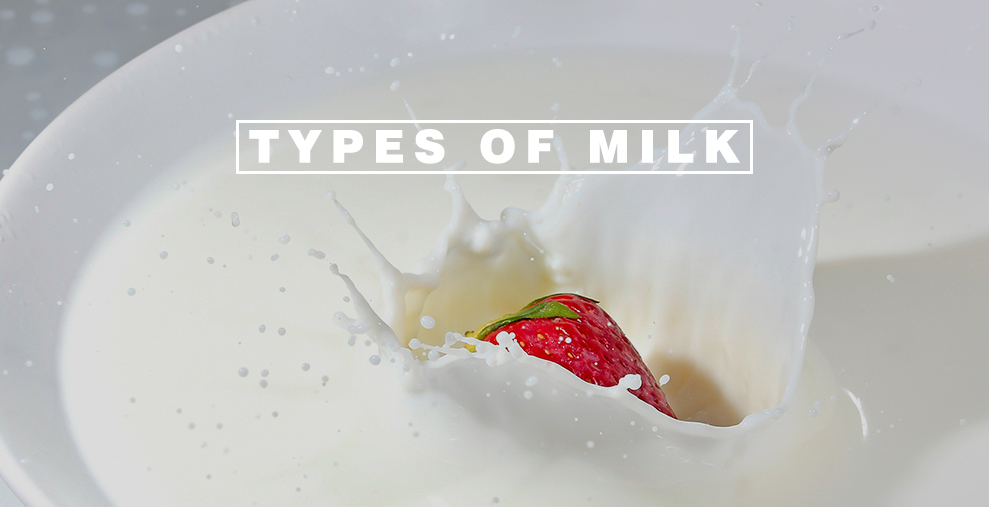There are a large number of different kinds of milk, some common and well-known, some less so. For those who stick to their everyday milk and aren’t aware of some of the less common types, we’ve put together a list of different kinds of milk and explained the differences between them.

Milk
1. Reduced-fat milk and low-fat milk
While the terms ‘reduced-fat’ and ‘low-fat’ seem interchangeable, when it comes to milk they actually have separate and distinct meanings. Reduced fat milk is milk with a fat percentage of 2%, whereas low fat milk is milk with a fat percentage of 1%. While these milks have less calories and saturated fat, they also have less nutritional value, as fat-soluble vitamins D, A, E, and K end up being mostly removed with the fat. However, some companies have found ways to add the lost vitamins back in to ensure their milk is still nutritionally strong.
2. Long-life milk
Also known as UHT (ultra-high temperature) milk, long life milk is milk that is pasteurised at a much higher temperature than regular milk. Specifically, the milk is heated to above 135°C for 1-2 seconds, as opposed to regular milk which is heated to just over 70°C for 15 seconds. The way UHT milk is pasteurised gives it an unrefrigerated shelf life of six to nine months, hence the name. Unless specified otherwise on the label, UHT milk is very similar to whole milk in terms of nutrition and fat content.
3. Goat milk
The name’s rather self-explanatory for this one, but how does it stack up against cow’s milk? Well to start off, it’s higher in calories and fat, including saturated fat. However, it’s lower in sugar, much higher in calcium and magnesium, and contains 5% of your daily vitamin C. It also has slightly more protein, much more potassium, and more vitamin A. Cow’s milk has the upper hand when it comes to vitamin B12 and folate, and both have similar amounts of cholesterol and vitamin D. However, cow’s milk comes out on top when it comes to selenium and B12, making choosing between the two harder than you might have thought.
4. Nut and seed-based milk
If you’re looking for a dairy-free alternative to milk but don’t particularly fancy soy milk, there’s always nut and seed-based milks. Almond milk in particular is widely available in supermarkets, but dairy alternatives can also easily be made from cashews and flaxseed. These dairy alternatives are free of cholesterol and saturated fats, containing only healthy, monounsaturated fats. They can also be lower in calories, higher in Riboflavin (also known as vitamin B2) and studies have shown that almond milk in particular could be helpful in supressing prostate cancer cells.
5. Soy milk
Probably the most well-known dairy alternative, soy milk is made from soybeans that have been soaked in water and then ground up in water. Soy milk is a complete protein, and has roughly the same amount of protein as whole milk. However, it’s less useful in the way of calcium, as the calcium found in soy beans is indigestible by humans. That being said, many soy milks are fortified with calcium during production. Soy milk has very little saturated fat and no cholesterol.
6. Regular or ‘whole milk’
Whole milk is defined as milk with a fat percentage of somewhere between 3.25% and 3.5%. It’s more or less the closest you can get to drinking milk the way it comes from the cow before being processed. While it will be pasteurised and (probably) homogenised, it has the same ratio of fat to milk as raw milk. Whole milk has the highest amount of calories and saturated fat of any type of milk, along with more cholesterol.
7. Skim milk
Also known as skimmed milk, skim milk is milk with zero fat. Because of its lack of fat, it’s generally thinner than other milks, which some companies combat by adding powdered milk, which can contain carcinogens such as oxidised cholesterol. However, not all skim milk contains additives, so be sure to check the label and list of ingredients to ensure that you know what you’re buying.
At the end of the day there’s a whole lot of different milks and milk alternatives, so whether you want to stick with your whole milk or try something more adventurous like flaxseed milk, you really can’t go wrong with whatever you end up choosing.
